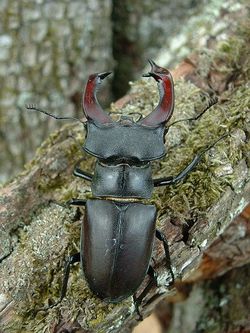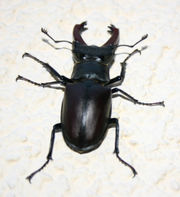Stag beetle
2007 Schools Wikipedia Selection. Related subjects: Insects, Reptiles and Fish
| iStag beetles | ||||||||||||||||
|---|---|---|---|---|---|---|---|---|---|---|---|---|---|---|---|---|
 Male Lucanus cervus
|
||||||||||||||||
| Scientific classification | ||||||||||||||||
|
||||||||||||||||
|
|
||||||||||||||||
|
not a complete list |
Stag beetles are a group of about 1,200 species of beetle in the family Lucanidae, the most well-known species being Lucanus cervus, a large beetle found in much of Europe. Some species grow to 8 cm (3.25 in), but usually they are about 5 cm (2 in).
The name is derived from the large and distinctive mandibles found on the males, which are used in much the same way as the antlers on stags are between males competing for mates. Carolus Linnaeus named the beetle Lucanus cervus. Pliny the Elder noted that Nigidius called the stag beetle lucani after the Italian region of Lucania where they were used as amulets.
Once common over much of Southern England and Wales, they have been in decline over the last 50 years and are now becoming rare and are listed as a globally threatened / declining species. They have become a protected species under Schedule 5 of the UK's Wildlife and Countryside Act 1981 and the EU Habitats Directive of the Berne Convention. Two of the most important London areas for stag beetles are Richmond Park and Wimbledon Common.
Adults appear during late May to the beginning of August being most active in the evenings. Females lay their eggs in a piece of decaying wood. Stag Beetle larvae, which are blind and shaped like a letter "C", feed on rotting wood in a variety of places, tree stumps, old trees and shrubs, rotting fence posts, compost heaps and leaf mould. The larvae have a cream-coloured soft transparent body with six orange legs, and an orange head which is very distinct from the very sharp brown pincers. They have combs in their legs which they use for communication ( stridulation) with other larvae. The larvae go through several developmental stages ( instars), taking 4 to 6 years to become pupae. The work of entomologist Charlie Morgan during the late 1970s discovered that the pupae of the Stag Beetle live in the soil for about 3 months, then emerge in summer to awkwardly fly off to mate. Adults only live for a few months feeding on nectar and tree sap. Their slow, lumbering flight, usually at dusk, makes a distinctive low-pitched buzzing sound. The males fly more readily than the females. The modern Italian word for a toy kite cervo volante (and hence the French cerf-volant) may derive from the ancient amusement of flying the beetles on a length of thread.
The Stag beetle is preyed upon by magpies, chickens, badgers, foxes, hedgehogs, cats, and woodpeckers.
The natural reaction of the beetle to an approaching large object is to remain motionless making them a good photographic subject. Sexually dimorphic, the males have enlarged mandibles and are larger than the females. Although the male's mandibles seem threatening, they are too weak to be harmful. Nevertheless, females can inflict a painful bite.

